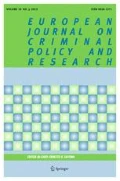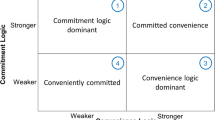Abstract
It is becoming common to read that antiquities without a provenance stretching back to before the 1970 adoption by UNESCO of the Convention on the Means of Prohibiting and Preventing the Illicit Import, Export and Transfer of Ownership of Cultural Property are increasingly difficult to sell because of customer concerns over possible illicit trade in the past and reduced resale prices in the future. This paper proposes the term autoregulation to describe the phenomenon, and presents the results of several quantitative analyses designed to investigate its action.

Similar content being viewed by others
Notes
The previous record had been set in June 2007 when a Roman bronze figure of Artemis and the Stag, known since 1953 when it was acquired by the Albright-Knox Art Gallery in Buffalo New York, exceeded its pre-sale estimate of $5-7 million when it sold for $28.6 million (Baugh 2007).
The previous record had been $29 million for a piece by Pablo Picasso (Baugh 2007).
Though as the context and circumstances of its discovery remain unknown, its historical significance is really only a matter for conjecture.
The first million dollar museum acquisition was in 1972 when the Metropolitan Museum of Art paid $1 million to dealer Robert Hecht for the Attic ‘Euphronios’ krater. Several more multi-million dollar museum acquisitions followed before the first object to break the million dollar barrier at auction in 1988, in the sale noted by Borodkin when a Cycladic figurine fetched $2.09 million in New York (Nørskov 2002 : 291–2).
Data from Christie’s London 14 April 2011 were not included because of the quantity of material from the Empain Collection, which had all been acquired sometime between 1905 and 1929, thus preventing a good division of material based on a 1930 date.
References
Adler, M. A., & Bruning, S. B. (Eds.). (2012). The futures of our pasts: ethical implications of collecting antiquities in the twenty-first century. Santa Fe: School for Advanced Research.
Adler, A. L., & Urice. (2011). Resolving the disjunction between cultural property policy and law a call for reform. Rutgers Law Review, 64(1), 117–163.
Akerlof, G. A. (1970). The market for ‘lemons’: quality uncertainty and the market mechanism. Quarterly Journal of Economics, 84(3), 488–500.
ATG (1999). Digging a little deeper to find early treasures. Antiques Trade Gazette, 6 November, 5.
Baugh, M. (2007). Antiquities: The hottest investment. Time, 12 December. http://www.time.com/time/business/article/0,8599,1693792,00.html. Accessed 11 July 2013.
Blake, J. (1998). Illicit antiquities and international litigation: the Turkish experience. Antiquity, 72, 824–830.
Blumenthal, R. & Mashberg, T. (2012). The curse of the outcast object. New York Times, 12 July. http://www.nytimes.com/2012/07/15/arts/design/antiquity-market-grapples-with-stricter-guidelines-for-gifts.html?pagewanted=all&_r=0. Accessed 11 July 2013.
Borodkin, L. (1995). The economics of antiquities looting and a proposed legal alternative. Columbia Law Review, 95, 377–417.
Braithwaite, J. (2002). Restorative justice and responsive regulation. New York: Oxford University Press.
Brodie, N., Doole, J., & Watson, P. (2000). Stealing history: the illicit trade in cultural material. Cambridge: McDonald Institute.
Brodie, N., Kersel, M. M., Luke, C., & Tubb, K. W. (Eds.). (2006). Archaeology, cultural heritage and the antiquities trade. Gainesville: University Press of Florida.
Cannon-Brookes, P. (1994). Antiquities in the market place: Placing a price on documentation. Antiquity, 68, 349–350.
Chappell, D., & Polk, K. (2011). Unraveling the “chordata”: Just how organized is the international traffic in cultural objects? In S. Manacorda & D. Chappell (Eds.), Crime in the art and antiquities world (pp. 99–116). New York: Springer.
Chippindale, C., & Gill, D. (2000). Material consequences of contemporary classical collecting. American Journal of Archaeology, 104(3), 463–511.
Elia, R. J. (2009). Mythology of the antiquities market. In J. A. R. Nafziger & A. M. Nicgorski (Eds.), Cultural heritage issues: the legacy of conquest, colonization, and commerce (pp. 239–256). Leiden: Martinus Nijhof.
Forrest, C. (2010). International law and the protection of cultural heritage. London: Routledge.
Gay, M. (2012). For the St. Louis Art Museum, a legal victory raises ethical questions. Atlantic, 30 May. http://www.theatlantic.com/national/archive/2012/05/for-the-st-louis-art-museum-a-legal-victory-raises-ethical-questions/257839/. Accessed 11 July 2013.
Gerstenblith, P. (2013). Has the market in antiquities changed in light of recent legal developments? In M. A. Adler & S. B. Bruning (Eds.), The Futures of Our Pasts: Ethical Implications of Collecting Antiquities in the Twenty-first Century (pp. 67–84). Santa Fe: School for Advanced Research.
Gill, D. (2013). Recently surfaced antiquities on the market. http://lootingmatters.blogspot.co.uk/2013/06/recently-surfaced-antiquities-on-market.html. Accessed 11 July 2013.
Grimes, W. (2009). Jan Mitchell, who put the ü back in Lüchow’s, dies at 96. New York Times, 30 November. http://www.nytimes.com/2009/12/01/nyregion/01mitchell.html. Accessed 11 July 2013.
Jones, J. (1985). The art of precolumbian gold. The Jan Mitchell collection. New York: Metropolitan Museum of Art.
Kaye, L. & Main, C. (1995). The saga of the Lydian Hoard: from Uşak to New York and back again. In K. W. Tubb (Ed.), Antiquities: Trade or Betrayed (pp. 150–161). London Archetype.
Lazrus, P. K., & Barker, A. W. (Eds.). (2012). All the King’s horses. Washington DC: Society for American Archaeology.
Mackenzie, S. R. M. (2005). Going, going, gone: Regulating the market in illicit antiquities. Leicester: Institute of Art and law.
Mackenzie, S. R. M., & Green, P. (Eds.). (2009). Criminology and archaeology. Oxford: Hart.
Manacorda, S., & Chappell, D. (Eds.). (2011). Crime in the art and antiquities world. New York: Springer.
Melikian, S. (1995). A degree of destruction unprecedented in the history of the world—and yet I support collecting. Art Newspaper, 52, 27.
Melikian, S. (2008). A wake-up call for the antiquities market. New York Times, 12 June. http://www.nytimes.com/2008/06/14/arts/14iht-melik14.1.13666041.html?pagewanted=all. Accessed 11 July 2011.
Melikian, S. (2010). Wanted: Antiquities beyond reproach. New York Times, 17 December. http://www.nytimes.com/2010/12/18/arts/18iht-melik18.html?pagewanted=all. Accessed 11 July 2013.
Melikian, S. (2012). How UNESCO’s 1970 Convention is weeding looted artifacts out of the antiquities market. Blouin ArtInfo. http://www.blouinartinfo.com/news/story/822209/how-unescos-1970-convention-is-weeding-looted-artifacts-out-of-the-antiquities-market. Accessed 11 July 2013.
Melikian, S. (2013). Antiquities, with a proven record, drive auction market. New York Times, 14 June. http://www.nytimes.com/2013/06/15/arts/15iht-melikian15.html?pagewanted=all. Accessed 11 July 2013.
Nafziger, J. A. R., & Nicgorski, A. M. (Eds.). (2009). Cultural heritage issues: the legacy of conquest, colonization, and commerce. Leiden: Martinus Nijhof.
Nørskov, V. (2002). Greek vases in new contexts. Aarhus: Aarhus University Press.
O’Keefe, P. J. (2000). Codes of ethics and the art trade. In F. Francioni, A. Del Vecchio, & P. De Caterini (Eds.), Protezione internazionale del patrimonio culturale: interessi nazionali e difesa del patrimonio comune della cultura (pp. 141–154). Rome: Giuffrè.
O’Keefe, P. J. (2007). Commentary on the 1970 UNESCO convention. Leicester: Institute of Art and Law.
Prott, L. (2000). UNESCO celebrates thirtieth anniversary of its convention on illicit traffic. International Journal of Cultural Property, 9, 347–349.
Rhodes, R. F. (Ed.). (2007). The acquisition and exhibition of classical antiquities. Notre Dame: University of Notre Dame Press.
Rountree, C. (2008). The Geddes Collection. Bonhams Magazine, Autumn, 43.
Russell, H. (2004). Western antiques: the past year has seen a concerted effort by auction houses and dealers to put past troubles in the market behind them, and concentrate on well-provenanced objects of high quality.Apollo, 1 December. http://www.thefreelibrary.com/Western+antiques%3A+the+past+year+has+seen+a+concerted+effort+by…-a0126194880. Accessed 11 July 2013.
Sotheby’s. (2010). Antiquities from the collection of the late Clarence Day. New York: Sotheby’s.
Squires, N. (2008). Suspicions that Roman artefacts were illegally traded. Telegraph, 16 October.
Tijhuis, E. (2006). Transnational crime and the interface between legal and illegal actors: The case of the illicit art and antiquities trade. Nijmegen: Wolf Legal.
Tsirogiannis, C. (2013). Something is confidential in the state of Christie’s. Journal of Art Crime Research, Spring, 3–20.
Watson, P. (1997). Sotheby’s: Inside story. London: Bloomsbury.
Watson, P., & Todeschini, C. (2007). The Medici conspiracy. New York: Public Affairs.
Acknowledgments
The research leading to these results has received funding from the European Research Council under the European Union’s Seventh Framework Programme (FP7/2007–2013)/ERC Grant agreement no. 283873. The data and issues discussed were first presented in May 2013 at the Vulnerability and Cultural Heritage conference held at the University of Leicester, and thanks are due to Professor Janet Ulph for organising the conference and inviting the author to attend.
Author information
Authors and Affiliations
Corresponding author
Rights and permissions
About this article
Cite this article
Brodie, N. Provenance and Price: Autoregulation of the Antiquities Market?. Eur J Crim Policy Res 20, 427–444 (2014). https://doi.org/10.1007/s10610-014-9235-9
Published:
Issue Date:
DOI: https://doi.org/10.1007/s10610-014-9235-9




